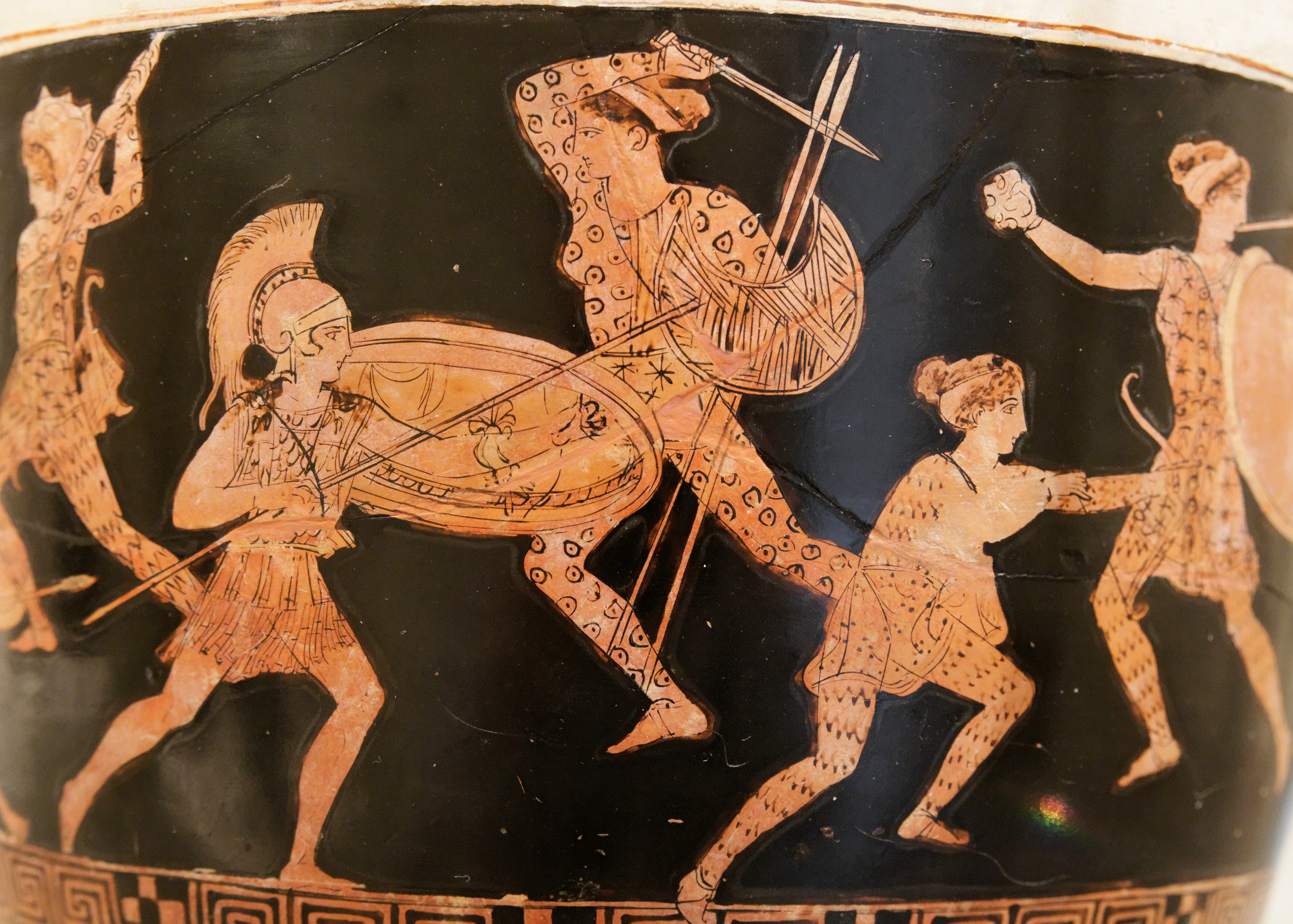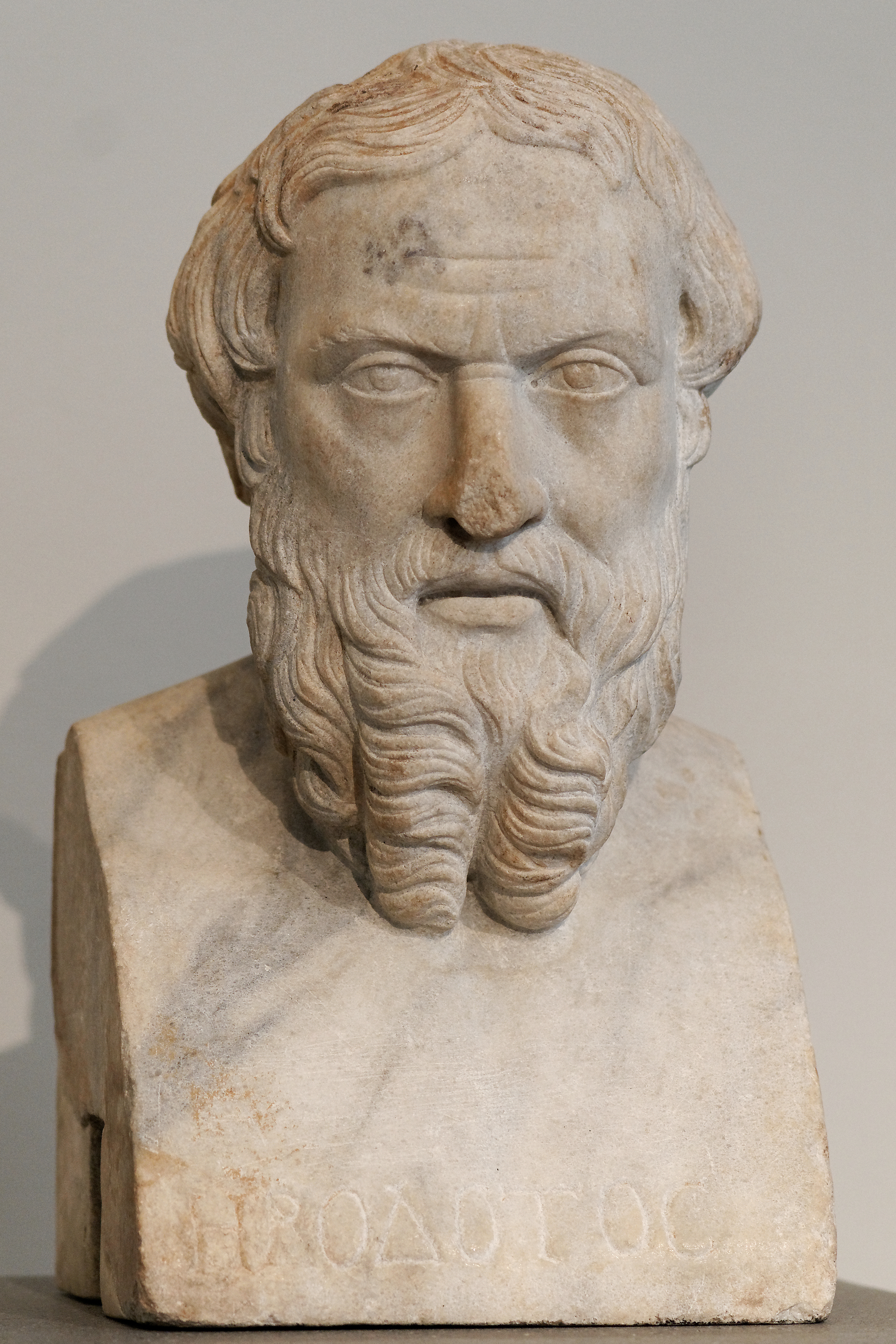|
Amazonomachy
In Greek mythology, Amazonomachy ( English translation: "Amazon battle"; plural, Amazonomachiai ( grc, Ἀμαζονομαχίαι) or Amazonomachies) was one of various mythical battles between the ancient Greeks and the Amazons, a nation of all-female warriors. Many of the myths portrayed were that of Heracles' ninth labor, which was the retrieval of the girdle of Hippolyta, Queen of the Amazons; and of Theseus' abduction of Hippolyta (or Antiope), whom he claimed as his wife, sparking the Attic War. Another famous scene portrayed is that of Achilles' victorious battle against Penthesilea during the Trojan war. The subject was popular in ancient Greek art and Roman art. Symbolism of Amazonomachy Amazonomachy represents the Greek ideal of civilization. The Amazons were portrayed as a savage and barbaric race, while the Greeks were portrayed as a civilized race of human progress. According to Bruno Snell's view of Amazonomachy: For the Greeks, the Titanomachy and the ba ... [...More Info...] [...Related Items...] OR: [Wikipedia] [Google] [Baidu] |
Amazons
In Greek mythology, the Amazons (Ancient Greek: Ἀμαζόνες ''Amazónes'', singular Ἀμαζών ''Amazōn'', via Latin ''Amāzon, -ŏnis'') are portrayed in a number of ancient epic poems and legends, such as the Labours of Hercules, the ''Argonautica'' and the '' Iliad''. They were a group of female warriors and hunters, who beat men in physical agility and strength, in archery, riding skills, and the arts of combat. Their society was closed for men and they only raised their daughters, either killing their sons or returning them to their fathers, with whom they would only socialize briefly in order to reproduce. Courageous and fiercely independent, the Amazons, commanded by their queen, regularly undertook extensive military expeditions into the far corners of the world, from Scythia to Thrace, Asia Minor and the Aegean Islands, reaching as far as Arabia and Egypt. Besides military raids, the Amazons are also associated with the foundation of temples and ... [...More Info...] [...Related Items...] OR: [Wikipedia] [Google] [Baidu] |
Warfare In Ancient Greek Art
Warfare was a common occurrence in Greece from the Neolithic Period through its conquest by Alexander the Great and until its conquest by the Roman Empire. Because of this, warfare was a typical theme in many pieces of ancient Greek art. Many works of art, like the Doryphoros or the chryselephantine statue of Athena Parthenos, used military objects in their composition, and many others, like the Chigi vase, had warfare as their main subject. Ancient Greek art is an important aspect of not just the history of art, but the history of warfare as well, due to its frequent spot on many works of ancient Greek art. As each different period in Greek history occurred, more and more types of art formed, as well as differing depictions of warfare. Bronze Age In Minoan art, warfare is not explicitly shown, but rather different interpretations were made that could tie into warfare. For example, bull-leaping was an activity Minoan men did and the struggle between man and bull could be a de ... [...More Info...] [...Related Items...] OR: [Wikipedia] [Google] [Baidu] |
Attic War
In Greek mythology, the Attic War is the conflict between the Amazons, led by Amazon queen Penthesilea, and the Athenians, led by Theseus or Heracles. The war lasted 4 months and concluded with a peace treaty in Horeomosium, near the temple of Theseus. Depending on the version of the myth, the Amazons fought to free either Antiope or her sister Hippolyta from captivity after her abduction at the hands of a Greek hero. Another version states Antiope waged war on Theseus to avenge him marrying Phaedra. Per some Greek myths, Heracles abducted Hippolyta during his ninth labor and later gave her to Theseus. Per other myths, Hippolyta was killed during the ninth labor and Theseus, who had joined Hercules during his expedition, abducted Hippolyta's sister Antiope. Siege of Athens Plutarch states that the Amazons had most likely conquered most of the Athenian state, for having reached the Pnyx and the Museum of Athens (Museum here refers to a building or temple dedicated to Muses ... [...More Info...] [...Related Items...] OR: [Wikipedia] [Google] [Baidu] |
Greco-Persian Wars
The Greco-Persian Wars (also often called the Persian Wars) were a series of conflicts between the Achaemenid Empire and Greek city-states that started in 499 BC and lasted until 449 BC. The collision between the fractious political world of the Greeks and the enormous empire of the Persians began when Cyrus the Great conquered the Greek-inhabited region of Ionia in 547 BC. Struggling to control the independent-minded cities of Ionia, the Persians appointed tyrants to rule each of them. This would prove to be the source of much trouble for the Greeks and Persians alike. In 499 BC, the tyrant of Miletus, Aristagoras, embarked on an expedition to conquer the island of Naxos, with Persian support; however, the expedition was a debacle and, preempting his dismissal, Aristagoras incited all of Hellenic Asia Minor into rebellion against the Persians. This was the beginning of the Ionian Revolt, which would last until 493 BC, progressively drawing more regions of Asia Minor into ... [...More Info...] [...Related Items...] OR: [Wikipedia] [Google] [Baidu] |
Persia
Iran, officially the Islamic Republic of Iran, and also called Persia, is a country located in Western Asia. It is bordered by Iraq and Turkey to the west, by Azerbaijan and Armenia to the northwest, by the Caspian Sea and Turkmenistan to the north, by Afghanistan and Pakistan to the east, and by the Gulf of Oman and the Persian Gulf to the south. It covers an area of , making it the 17th-largest country. Iran has a population of 86 million, making it the 17th-most populous country in the world, and the second-largest in the Middle East. Its largest cities, in descending order, are the capital Tehran, Mashhad, Isfahan, Karaj, Shiraz, and Tabriz. The country is home to one of the world's oldest civilizations, beginning with the formation of the Elamite kingdoms in the fourth millennium BC. It was first unified by the Medes, an ancient Iranian people, in the seventh century BC, and reached its territorial height in the sixth century BC, when Cyrus the Gre ... [...More Info...] [...Related Items...] OR: [Wikipedia] [Google] [Baidu] |
Achaemenid Empire
The Achaemenid Empire or Achaemenian Empire (; peo, 𐎧𐏁𐏂, , ), also called the First Persian Empire, was an ancient Iranian empire founded by Cyrus the Great in 550 BC. Based in Western Asia, it was contemporarily the largest empire in history, spanning a total of from the Balkans and Egypt in the west to Central Asia and the Indus Valley in the east. Around the 7th century BC, the region of Persis in the southwestern portion of the Iranian plateau was settled by the Persians. From Persis, Cyrus rose and defeated the Median Empire as well as Lydia and the Neo-Babylonian Empire, marking the formal establishment of a new imperial polity under the Achaemenid dynasty. In the modern era, the Achaemenid Empire has been recognized for its imposition of a successful model of centralized, bureaucratic administration; its multicultural policy; building complex infrastructure, such as road systems and an organized postal system; the use of official languages acro ... [...More Info...] [...Related Items...] OR: [Wikipedia] [Google] [Baidu] |
Attis
Attis (; grc-gre, Ἄττις, also , , ) was the consort of Cybele, in Phrygian and Greek mythology. His priests were eunuchs, the ''Galli'', as explained by origin myths pertaining to Attis castrating himself. Attis was also a Phrygian vegetation deity. His self-mutilation, death, and resurrection represents the fruits of the earth, which die in winter only to rise again in the spring. According to Ovid's ''Metamorphoses'', Attis transformed himself into a pine tree. No connection to the god Atys Nineteenth century scholarship wrongly identified the god ''Attis'' with the similar-sounding name of the god ''Atys''. The ''name'' "Atys" is often seen in ancient Aegean cultures; it was mentioned by Herodotus, however Herodotus was describing Atys, the son of Croesus, a human in a historical account. The 19th century conflation of the man Atys's name with the mythology of the god he was presumably named after, "Atys the sun god, slain by the boar's tusk of winter" ... [...More Info...] [...Related Items...] OR: [Wikipedia] [Google] [Baidu] |
Josine Blok
Josine Henriëtte Blok (born 9 June 1953) is a Dutch classical scholar. She has been a professor of Ancient History and Classical Civilisation at Utrecht University since 2001 up until 2019. Blok was born in Oegstgeest. She attended the gymnasium and subsequently studied history at the University of Groningen between 1971 and 1978. In October 1991, she obtained her PhD at Leiden University under professor , with a thesis titled: "Amazones antianeirai. Interpretaties van de Amazonenmythe in het mythologisch onderzoek van de 19e en 20e eeuw en in archaïsch Griekenland". In 2001, Blok was appointed professor at Utrecht University. In 2003, Blok was awarded a Vici grant by the Netherlands Organisation for Scientific Research for research on citizenship in Classical Athens. She was elected a member of the Royal Netherlands Academy of Arts and Sciences The Royal Netherlands Academy of Arts and Sciences ( nl, Koninklijke Nederlandse Akademie van Wetenschappen, abbreviated: KNAW) i ... [...More Info...] [...Related Items...] OR: [Wikipedia] [Google] [Baidu] |
Troy
Troy ( el, Τροία and Latin: Troia, Hittite: 𒋫𒊒𒄿𒊭 ''Truwiša'') or Ilion ( el, Ίλιον and Latin: Ilium, Hittite: 𒃾𒇻𒊭 ''Wiluša'') was an ancient city located at Hisarlik in present-day Turkey, south-west of Çanakkale and about miles east of the Aegean Sea. It is known as the setting for the Greek myth of the Trojan War. In Ancient Greek literature, Troy is portrayed as a powerful kingdom of the Heroic Age, a mythic era when monsters roamed the earth and gods interacted directly with humans. The city was said to have ruled the Troad until the Trojan War led to its complete destruction at the hands of the Greeks. The story of its destruction was one of the cornerstones of Greek mythology and literature, featuring prominently in the ''Iliad'' and the ''Odyssey'', and referenced in numerous other poems and plays. Its legacy played a large role in Greek society, with many prominent families claiming descent from those who had fought there. In the ... [...More Info...] [...Related Items...] OR: [Wikipedia] [Google] [Baidu] |
Quintus Smyrnaeus
Quintus Smyrnaeus (also Quintus of Smyrna; el, Κόϊντος Σμυρναῖος, ''Kointos Smyrnaios'') was a Greek epic poet whose ''Posthomerica'', following "after Homer", continues the narration of the Trojan War. The dates of Quintus Smyrnaeus' life and poetry are disputed: by tradition, he is thought to have lived in the latter part of the 4th century AD, but early dates have also been proposed. His epic in fourteen books, known as the ''Posthomerica'', covers the period between the end of Homer's ''Iliad'' and the end of the Trojan War. Its primary importance is as the earliest surviving work to cover this period, the archaic works in the Epic Cycle, which he knew and drew upon, having been lost. His materials are borrowed from the cyclic poems from which Virgil (with whose works he was probably acquainted) also drew, in particular the ''Aethiopis'' (''Coming of Memnon'') and the '' Iliupersis'' (''Destruction of Troy'') of Arctinus of Miletus, the now-lost ''Heleneis'' ... [...More Info...] [...Related Items...] OR: [Wikipedia] [Google] [Baidu] |
Feminism
Feminism is a range of socio-political movements and ideologies that aim to define and establish the political, economic, personal, and social equality of the sexes. Feminism incorporates the position that society prioritizes the male point of view and that women are treated unjustly in these societies. Efforts to change this include fighting against gender stereotypes and improving educational, professional, and interpersonal opportunities and outcomes for women. Feminist movements have campaigned and continue to campaign for women's rights, including the right to vote, run for public office, work, earn equal pay, own property, receive education, enter contracts, have equal rights within marriage, and maternity leave. Feminists have also worked to ensure access to contraception, legal abortions, and social integration and to protect women and girls from rape, sexual harassment, and domestic violence. Changes in female dress standards and acceptable physical ... [...More Info...] [...Related Items...] OR: [Wikipedia] [Google] [Baidu] |







